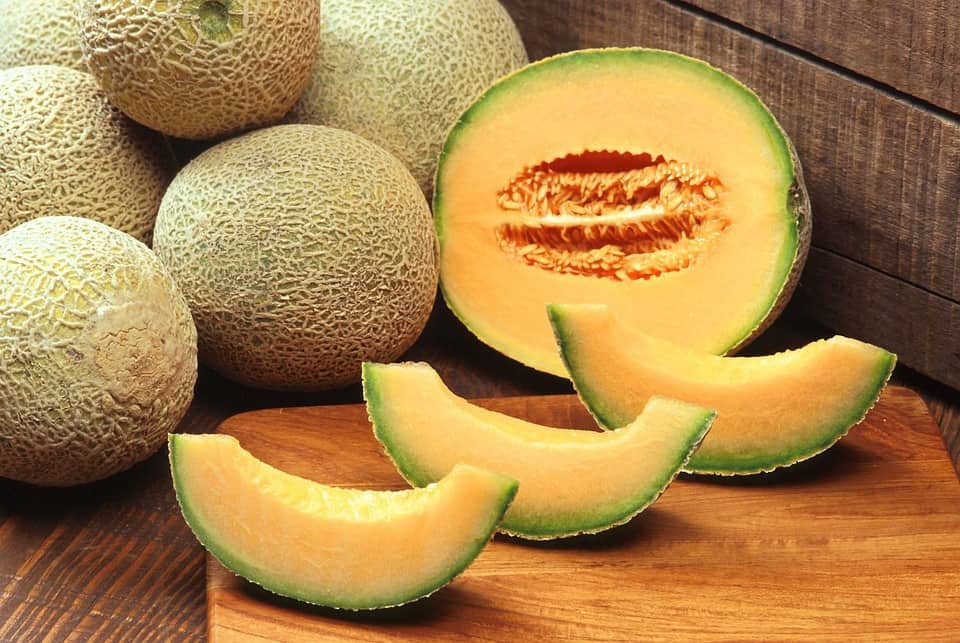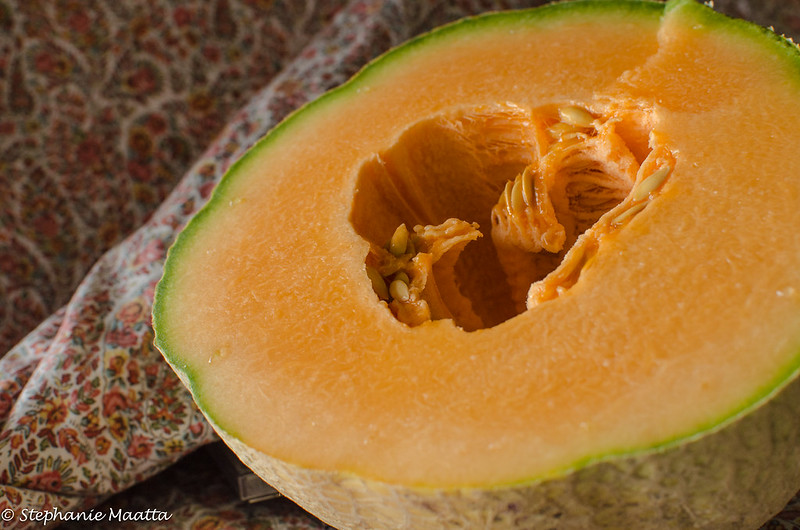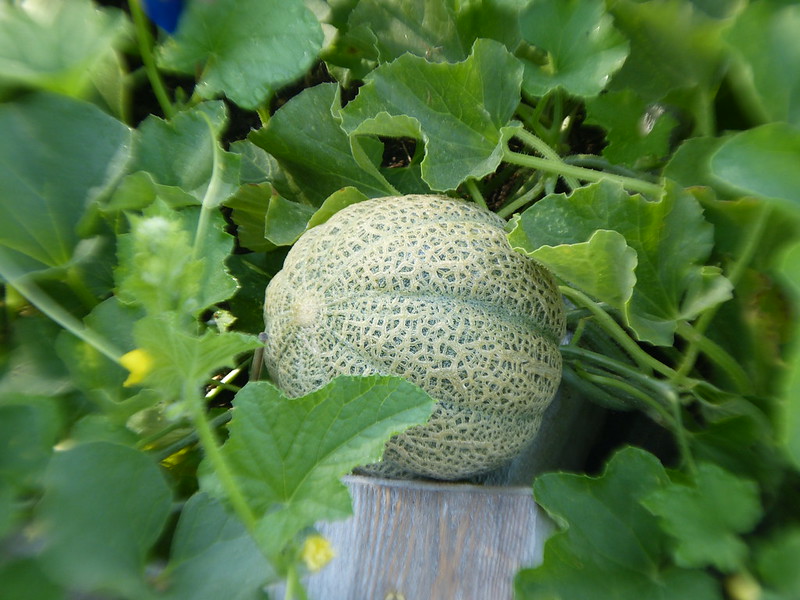Gardeners are always trying to find ways to grow sweeter melons, and it’s even more important when growing cantaloupes. A tart strawberry can still taste good, but an unsweet cantaloupe will put a lot of people off.
Fortunately, there are not only ways to increase the sweetness of your cantaloupes on the vine but there are also cantaloupe varieties which were bred specifically for their high sugar content (measured in Brix, or percentage of sugar). Below are the sweetest cantaloupe varieties on the market, where to find seeds, and tips to help them reach their potential in flavor and sweetness in your garden.
| Cantaloupe Variety | Brix (sugar %) | Days to Maturity | Disease Resistance(s) |
|---|---|---|---|
| Sugar Cube | 11-14% | 80 days | F(0,1,2), PM(1,2), WMV, PRSV, ZYMV |
| Honey Rock | 13.1% | 80 to 85 days | F |
| El Gordo | 10-16% | 75 to 85 days | PM, WMV |
| Hannah’s Choice | 12-14% | 75 to 85 days | PM, F(2), ZYMV, PRSV, WMV |
| Ambrosia | 13-16% | 85 to 90 days | PM |
| Halona | 9.4-15% | 70 to 75 days | F(0,1,2), PM |
| Sarah’s Choice | 10.9-14% | 75 to 80 days | F(0,1,2), PM |
Disease acronyms: F (Fusarium Wilt); PM (Powdery Mildew); WMV (Watermelon Mosaic Virus); PRSV (Papaya Ringspot Virus); ZYMV (Zucchini Yellow Mosaic Virus); numbers refer to specific races (strains) of those diseases
Note to international readers: Many of the US-based seed companies mentioned in this article also ship internationally.
On this page:
Sweetest Cantaloupe Varieties to Grow
Sugar Cube
One of the most disease-resistant cantaloupes on the market with intensely aromatic flesh
Days to Maturity: 80 days
Brix (sugar content): 11-14% [1][2]
Disease Resistance(s): F(0,1,2), PM(1,2), WMV, PRSV, ZYMV
Fruit Description: 2-4 lbs; round; coarsely netted skin
Open Pollinated? No (Hybrid)
Get seeds: Burpee (US), Johnny’s Selected Seeds (US), Renee’s Garden (US), Harris Seeds (US), Territorial Seed Company (US), Fedco Seeds (US), Park Seed (US), Stokes Seeds (Canada), T&T Seeds (Canada)

If diseases are ruining your cantaloupe harvests, Sugar Cube was specifically developed to resist all major melon diseases while retaining high levels of sweetness, flavor, aroma, and shelf life. This makes Sugar Cube perfect for both the home gardener and market grower looking to protect their yields.
These round, succulent muskmelons are of a modest size, typically 2 lbs but can reach up to 4 lbs, and have coarsely netted skin, but a fairly thin rind. The Brix content of Sugar Cube melons is consistently above 10%, up to an extremely high 14% under the right growing conditions, making them the ideal first choice for a disease-resistant sweet variety.
Honey Rock
The heirloom of choice for sweet, prolific harvests, and has been an AAS winner since 1933
Days to Maturity: 80 to 85 days
Brix (sugar content): 13.1% [3]
Disease Resistance(s): F
Fruit Description: 3-4 lbs; round; coarsely netted skin with shallow ridges
Open Pollinated? Yes (Heirloom)
Get seeds: MIGardener (US), Victory Seeds (US), Hoss (US), True Leaf Market (US), UF Seeds (US), Everwilde Farms (US), Eden Brothers (US)
Honey Rock melons are more like the cantaloupes your parents and grandparents ate: full of rich flavor, pleasant, musky aromas, and a sweetness that can compete toe-to-toe with any hybrid on this list. If you prefer growing open-pollinated, heirloom varieties, Honey Rock should be the first cantaloupe variety you try.
Most heirloom varieties are not super resistant to disease, but Honey Rock boasts moderate resistance to Fusarium wilt. In melons, Fusarium is one of the fungi that cause damping off in seedlings, and can weaken older, mature plants.
Honey Rock cantaloupes are usually personal-sized, around 3-4 lbs, but can occasionally grow larger, with some reporting up to 7-lb fruit. However, Honey Rock plants are also incredibly productive, easily producing 5 to 7 melons per plant.
El Gordo
A mammoth muskmelon with consistently high sweetness and excellent disease resistance
Days to Maturity: 75 to 85 days
Brix (sugar content): 10-16% [1][4]
Disease Resistance(s): PM, WMV
Fruit Description: 15-20 lbs; elongated; lightly netted skin
Open Pollinated? No (Hybrid)
Get seeds: NE Seed (US), Burpee (US), Holmes Seed Company (US), Seeds ‘n Such (US), Gurney’s (US), Home Depot (US)
You don’t have to trade size for flavor. El Gordo is a massive cantaloupe bursting with flavor and sweetness. El Gordo melons can easily reach a hefty 20 lbs, and even some 30-pounders have been harvested. Despite its size, the seed cavity is relatively small. El Gordo has very strong resistance to powdery mildew and good resistance to watermelon mosaic virus.
If you’re not a fan of strong musky aromas, El Gordo melons are only slightly aromatic, but still flavorful and very sweet. El Gordo consistently achieves a Brix rating of 10-12%, but can achieve up to a sugary sweet 16%, which is about as sweet as a cantaloupe can get. For comparison, wine grapes (which have more sugar than table grapes) are typically at 19% and higher.
Hannah’s Choice
Consistently sweet with a very high sugar content, developed for reliable disease resistance
Days to Maturity: 75 to 85 days
Brix (sugar content): up to 14% [5][8]
Disease Resistance(s): PM, F(2), ZYMV, PRSV, WMV
Fruit Description: 3-5 lbs; elongated; netted skin with light ribbing
Open Pollinated? No (Hybrid)
Get seeds: Johnny’s Selected Seeds (US), Fedco Seeds (US), Gurney’s (US), Vermont Bean Seed Company (US), Holmes Seed Company (US), Osborne Quality Seeds (US)
Hannah must have been a chef. A very popular cantaloupe variety, Hannah’s Choice is also the choice of many gardeners and gourmets, with prolific production, good-sized, highly aromatic, sweet melons. Hannah’s Choice was developed by breeders at Cornell University, so it’s well-adapted to producing consistently sweet melons (as high as 13-14% Brix) even in cooler climates. It also boasts a respectable resistance to most of the common diseases of the cucurbit family.
The melons themselves have a small seed cavity and vibrant orange flesh that give off a tropical fruit aroma, receiving accolades by commercial growers for consistent quality. Highly recommended if you’re a fan of the Sugar Cube but want to try growing a larger melon.
Ambrosia
One of the sweetest, most flavorful cantaloupes on the market, and a vigorous grower and classic melon
Days to Maturity: 85 to 90 days
Brix (sugar content): 13-16% [6]
Disease Resistance(s): PM
Fruit Description: 3-5 lbs; round; lightly netted skin
Open Pollinated? No (Hybrid)
Get seeds: Harris Seeds (US), Hometown Seeds (US), Hoss (US), Park Seed (US), True Leaf Market (US), Burpee (US), Swallowtail Garden Seeds (US), Gurney’s (US), UF Seeds (US), Totally Tomato (US), Jung Seed (US)
Ambrosia has been on the market for well over 20 years, which is a testament to its quality. Round cantaloupes grow on vigorous vines, producing consistent harvests of market-quality melons while boasting excellent resistance to powdery mildew, one of the most common diseases in the cucurbit family.
From the outside, Ambrosia looks like a typical grocery store cantaloupe, but the fragrant, sweet interior tells another story. Not only does Ambrosia have a small seed cavity, the creamy, peach-colored flesh is extremely sweet right up to the rind. Under the right growing conditions, Brix levels can reach a whopping 16%, making this an excellent dessert melon.
Even with newer, more disease-resistant hybrids on the market, this personal-sized cantaloupe has been (and continues to be) a favorite of market sellers for decades for a reason.
Halona
An early, heavy-yielding cantaloupe that doesn’t compromise on flavor
Days to Maturity: 70 to 75 days
Brix (sugar content): 9.4-15% [2][7]
Disease Resistance(s): F(0,1,2), PM
Fruit Description: 4-5 lbs; round; medium netting with light green ribbing
Open Pollinated? No (Hybrid)
Get seeds: Fedco Seeds (US), Johnny’s Selected Seeds (US), Territorial Seed Company (US), Seeds ‘n Such (US), Veseys (US), T&T Seeds (Canada), West Coast Seeds (Canada), William Dam Seeds (Canada), Veseys (Canada),
For those with short growing seasons, Halona was specifically bred to be sweet, a prolific yielder, and earlier than most other cantaloupes. Because it’s so productive and disease resistant, Halona is also recommended for those who have difficulty getting good yields when growing melons.
Usually when varieties are bred for earliness, they sacrifice flavor and sweetness. Not the case for Halona, which consistently scores very high in melon variety trials. Sweetness is also consistently high, with Brix levels between a refreshingly sweet 9.4% and a sugary sweet 15%. Like most of the varieties on this list, the seed cavity is relatively small, so you get more flesh per melon.
Sarah’s Choice
Bumper crops of uniform, round melons bursting with flavor and boasting good resistance to fungal diseases
Days to Maturity: 75 to 80 days
Brix (sugar content): 10.9-14% [2][9]
Disease Resistance(s): F(0,1,2), PM
Fruit Description: 3 lbs; oval with small seed cavity; light, fine netting with no ribbing
Open Pollinated? No (Hybrid)
Get seeds: Johnny’s Selected Seeds (US), Veseys (US), Gurney’s (US), Veseys (Canada)
Sarah’s Choice is one of the most high-yielding melons on this list that produces very sweet and intensely flavored fruit. This cantaloupe is ideal for commercial growers looking to sell good-sized, uniform fruits to market, but its high productivity and excellent flavor also make it a favorite for home gardeners as well.
In variety trials, Sarah’s Choice scores consistently high, with some reporting it was the sweetest in their trial. If fungal diseases like Fusarium wilt and powdery mildew keep killing off your vines, Sarah’s Choice is resistant to both PM and several strains of Fusarium.
Other Super Sweet Muskmelon/Cantaloupe Varieties
There are many other cantaloupe varieties with high Brix (sugar) levels which were not included above. Below are some commonly recommended varieties with an average sugar content comparable to the main list. Two varieties (Creme De La Creme and Dove) are technically ananas melons which are a bit different from cantaloupes, but they are so prized for their flavor and sweetness that they had to be mentioned.
- Aphrodite
- Olympic Express *
- Sugar Rush *
- Creme De La Creme (ananas variety) *
- Sweet Granite
- Hearts of Gold
- Goddess *
- Ball 2076
- Dove (ananas variety) *
- Sweet Passion
- Wrangler *
- Athena *
* highly recommended varieties
How to Get Sweeter Cantaloupes
Just like with people, how cantaloupes develop is a mix of nature and nurture. All the cantaloupe varieties above have a naturally higher potential (nature) of reaching high sugar levels, but whether they actually reach that potential depends on the growing conditions (nurture).
How sweet your cantaloupes get depends on several factors: ample sunlight, warmth, and nutrients during fruit development, and less water after the cantaloupes are ripening.
Plants need energy to produce sugar, so it stands to reason that the more sunlight your cantaloupe plants have, the sweeter your cantaloupes will be. Always grow your cantaloupes in full sun (at least 6 hours of unshaded, direct sun per day) to maximize the amount of energy your plants can get. Less sun not only means less sugar production, but also slower growth and ripening overall. Cool temperatures also slow down plant growth and fruit development.
Similarly, in order to ensure proper fruit development, ensure your cantaloupes are growing in rich, fertile soil. Planting in soil amended with compost or using a slow-release bloom/fruit fertilizer will ensure your cantaloupe plants have enough nutrients to grow and develop good yields of sweet melons.
Water is also important, and you should never let your cantaloupe plants dry out while they are growing, however, after your cantaloupes start ripening, reducing the amount of water will cause your cantaloupes to have a higher concentration of sugar. Because of this, the best time to harvest cantaloupes to maximize sweetness is on a sunny, hot day in the afternoon when the fruit has the least water content. But always make sure they are fully ripe, which is when the cantaloupe easily falls off the vine without twisting or pulling hard.
Pro-Tip: This strategy to get sweet cantaloupes also works for tomatoes, peppers, and other fruits! Harvest tomatoes on a hot day after a few days without rain and harvest them after they’ve been well-watered, and you can taste the difference.
Sources
[1] Twilley Seed. https://twilleyseed.com/vegetables/vegetables_melons
[2] Brown, Rebecca, “Melon Variety Trials, 2012” (2013). Rhode Island Agricultural Experiment Station Bulletin. Paper 3. https://digitalcommons.uri.edu/cgi/viewcontent.cgi?article=1003&context=riaes_bulletin [PDF]
[3] Organic Melons – A Niche Market – Cooperative Extension: Agriculture – University of Maine Cooperative Extension. https://extension.umaine.edu/agriculture/sustainable-agriculture/organic-melons-a-niche-market/
[4] Burpee. https://www.burpee.com/cantaloupe-el-gordo-hybrid-prod003506.html
[5] Johnny’s Selected Seeds. https://www.johnnyseeds.com/vegetables/melons/hannahs-choice-f1-melon-seed-3560.html
[6] Extreme Melon Growing. Wayne’s This and That. http://waynesthisandthat.com/melons
[7] Fedco Seeds. https://www.fedcoseeds.com/seeds/halona-muskmelon-970
[8] One Drop Farm. http://onedropfarm.com/product/hannahs-choice/
[9] Orzolek, Mike. 2011 Cantaloupe Variety Trial. Horticulture Research Farm. https://www.paveggies.org/wp-content/uploads/research-report-2011-12-cantaloupe-variety-evaluation.pdf [PDF]






